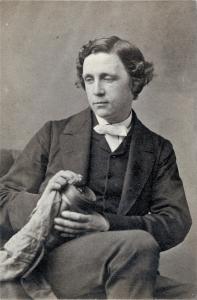Charles Lutwidge Dodgson was born at the All Saints’ vicarage in Cheshire, England, today, the 27th of January, in 1832. His family produced military men and clerics. His great grandfather a bishop in the Church of England, his father a country priest, later Archdeacon of Richmond. The family were Anglo-Catholics.
Charles’ early education was at home. He, like his siblings, apparently, suffered from a stammer. In 1846 he was shipped off to public school, and in 1849 entered Oxford. He would remain there for the rest of his life. While being ordained deacon in the church his real work was teaching mathematics.
His poetry was well received and he also enjoyed some recognition as a short story writer. In 1856 he adopted the pen name Lewis Carroll for his non mathematical writing.
While there are many legends around the Alice stories it does seem that he first began telling them to the Liddell children, including their youngest Alice. And it does appear she asked they be written down.
They were. The first was published in 1865 as Alice’s Adventures in Wonderland.
William Tuckwell described Dodgson as “austere, shy, precise, absorbed in mathematical reverie, watchfully tenacious of his dignity, stiffly conservative in political, theological, social theory, his life mapped out in squares like Alice’s landscape” He never married and maintained a modest life style. Because of the success of his writings he gradually acquired a small fortune.
He never married. In our times his interest among other hobbies in photographing nude girls (in addition to photographing famous literary figures) has been the cause for speculations about his sexuality. Karoline Leach, after a detailed study of the available documents, states contrary to a story that evolved well after his death he maintained considerable interest in adult women, both single and married. She suggests the hints of pedophilia are entirely a product of a later age, in part the result of ignorance of social mores in his time. Compounded, if inadvertently, by his family attempting to suppress what might have on occasion been scandalous connections with women. Including possibly an affair with a governess, or even a married woman. While my casual read suggests pedophilia latent or otherwise is unlikely, the truth of the matter is, given the evidence at hand, we are unlikely to ever know with certainty this part of the person who was both Henry Dodgson and Lewis Carroll.
While personally very conservative he had wide ranging religious interests, including being an early member of the Society for Psychical Research, as well as Theosophy.
Dodgson died from pneumonia brought on by influence, on 14 January, 1898. He was 65.
From time to time people notice what might be a bit of a koan in his writings. Koans are wondrous things. To the outsider reader they are sometimes taken as nothing more than non sequesters, or clever word play. Which is Carroll, a lot of the time.
And yet. Even those of us who hold more narrow definitions of koan, like Robert Aitken Roshi who said they present a matter to be made clear, or my preferred assertion about reality and an invitation to come to that place.
The author, editor, and renowned authority on Lewis Carroll, Mark Burstein suggests that Alice is “a derelict Canon of Zen Buddhism, full of koans…” Sadly, quickly revealing he knows little about Zen or, for that matter, koans. But, I liked his nerve, and, especially his writing. And anyone who offers “derelict canon of Zen…” deserves a lot of leeway in my book. A real Zen teacher Daniel Dogen Silberberg devoted a book to riffing off of Carroll to invite the reader into the Zen way.
Then while wandering around the web seeing who might be able to credibly connect Lewis Carroll and Zen, I stumbled upon Technology of the Heart, a blog that seems focused mostly on Islam, Sufism, and perhaps Traditionalism. The entry is titled “Sufi Zen Koan from Alice in Wonderland.”
First he offers a lovely line.
Be
what you
would seem to be —
or,
if you’d like it put more simply —
Never imagine yourself not to be otherwise
than what it might appear to others,
that what you were or might have been
was not otherwise than what you had been would have appeared
to them to be otherwise.
Within the word play there is a pointing. No doubt. One can find an assertion of our wild and mysterious interrelated being constantly presenting into the universe as the universe. Together with that invitation to notice.
Easy for this to be a koan.
And, quite interestingly, the article notes how the late Zen teacher Daido Loori liked to reference:
The caterpillar said, One side will make you grow bigger and the other side will make you grow smaller.” “One side of who? The other side of what?” though Alice to herself. “of the mushroom,” said the caterpillar. Alice looked at the mushroom, trying to make out which were the two side of it, as it was perfectly round.
A lovely invitation.
As I see it a bit more difficult to find the koan of it.But then perhaps that’s why the old teacher liked it. Throwing a little dust around is often part of the project.
And at the heart an assertion. And an invitation.
So, perhaps not a secret Zen canon, but Lewi Carroll did see something.
And for those of us who care about such matters an invitation into a world where things are not precisely as they seem, the language seems familiar, but perhaps is not immediately understandable. A passing strange world. Of delight. Of confusion.
Of invitation.
Thank you, Reverend Dodgson!













